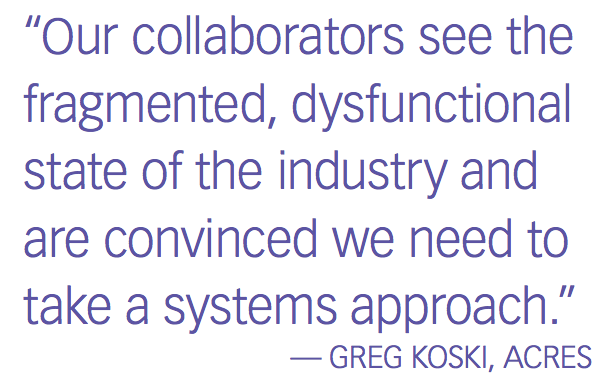‘Systems’ Spark Sought for Clinical Trials
Pharmaceutical Executive
The Alliance for Clinical Research Excellence and Safety (ACRES) is advocating a “systems thinking” approach in efforts to meet increasing demands to standardize and integrate support for trial sites.
Amid growing calls for more industry alignment on clinical trials, the Alliance for Clinical Research Excellence and Safety (ACRES) is prioritizing a “systems” approach to trial management. Reevaluating and standardizing the building blocks of high performing trial sites is a key first step.
Getty Images

In September 1999, the Mars Climate Orbiter, a $125 million satellite, was barreling towards Mars. As its thrusters fired to position the craft into an orbital trajectory, something was amiss. NASA engineers would eventually come to understand that the reason the orbiter incinerated in the Red Planet’s atmosphere, rather than beaming back the weather forecast, was a units conversion error. Software on the probe were calculating in pounds of force rather than the metric newtons-an expensive lesson for grade-school math classrooms and a nice advert that might have been useful for metric system conversion efforts in the Carter era.
The lesson for drug developers? The International System of Units (SI) are pretty much agreed upon across the life sciences. But many in the industry have asserted the need for all parties involved in clinical trials to come to terms on some metrics, and, generally, to get on the same page on some basic aspects surrounding clinical studies. Greg Koski, CEO of the Alliance for Clinical Research Excellence and Safety (ACRES), a multi-sector non-profit, sees the issue as more than just forging agreement on units. Koski sees the entirety of the drug development economy as a dysfunctional system, and he’s engineering a holistic approach.
Writing in Clinical Investigation earlier this year, Koski and his co-author, Matthew Whalen, drew on a slightly more earthbound analogy than extraterrestrial orbiters, contrasting the biopharma
Greg Koski

industry with systems that allow millions to skip around the globe over land and sea on 100,000-plus flights per day. Air traffic around the globe permits amazing feats of human engineering, and, thankfully, few disastrous incidents, via a system of intensely competitive stakeholders who are connected and collaborating. “This system depends upon the capture, interchangeability, and analysis of important operations and safety information at every step of the process-information shared by the many stakeholders for the benefit of the entire industry and the public it serves,” write Koski and Whalen.
Koski’s description of the “system” making flight possible is reminiscent of a comedy bit by comedian Louie C.K. “Everything’s amazing, but nobody’s happy,” it goes. The philosophical luminary castigates our whining culture that complains about the inconveniences of air travel while disregarding the fact that they can travel from coast to coast at hundreds of miles per hour and tens of thousand of feet thanks to the miracle that is human flight.
C.K.’s caustic disdain is aimed at the lack of appreciation for someone who is participating in the aerial engineering feat that is the “miracle of human flight.” But Koski-not to mention airlines, air traffic controllers, and the gate agent you just berated-might ask for your appreciation of the countless systems in place that can allow you to buy a seat, check in, process your luggage, track the plane over thousands of miles, monitor the weather, and compute countless flight parameters like longitude, latitude, altitude, air speed, etc.
If the first miracle is flight itself, the second miracle is the industry and system that coordinate it on a global scale. Perhaps it’s less useful as a punch line, but myriad providers, who are also competitors, operate more or less agreeably using common systems. In air travel, a system-wide agreement to cooperate is the foundation for competition.
Drug industry’s organizational fail-the challenge
Compared with the achievements of the aviation industry over the last half-century, Koski sees massive failure and opportunity in the drug industry. Drug development costs are immense and the process is glacially slow; those failures are well-documented. And it’s widely understood that a significant portion of drug research spending is wasted on inefficiencies inherent to the clinical trial process now in place. Should we consider this inexcusable and even unethical to allow inefficiencies to impact drug development while global health needs go unaddressed?
Also, an issue of ethics is patient safety, says Koski. Critical safety information may be unavailable in timely fashion, masked or otherwise blocked from appropriate scrutiny in our current clinical trials system. If airline safety data weren’t completely transparent, “that would be unconscionable, but in the drug industry, companies and regulatory agencies aren’t even allowed to share that information,” says Koski. “It’s crazy!”
So why has it been so problematic for the biopharma industry to come to terms with and standardize clinical trial practices that would accelerate and reduce the costs of drug development, while enhancing safety? It’s complicated.

ACRES is not the first effort to tackle these challenges nor is the group alone. Several “thoughtful reports have been published,” the ACRES group commented in Clinical Therapeutics in October 2014. “But few recommendations have been effectively realized in practice, in large measure because of the complexity of the ecosystem in which these endeavors are conducted and the absence of effective mechanisms, champions, or venues for implementation.”
ACRES is in good company with other “well-intentioned” organizations of which Koski and his co-authors list a few: the Clinical Trials Transformation Initiative (CTTI); TransCelerate Biopharma Inc.; the Innovative Medicines Initiative (IMI); the Multi-Regional Clinical Trials Center (MRCT); the European Clinical Research Infrastructure Network (ECRIN); and the Korean National Enterprise for Clinical Trials (KoNECT).
The volume and breadth of stakeholders to align is daunting. Koski et al. again enumerate the range of involved parties: pharmaceutical companies; regulatory agencies; professional organizations; trade organizations; academic research and medical centers; providers of products and services; research sites, site management organizations; contract research organizations (CROs), research professionals; ethics committees; business management units; patients; advocacy groups; media groups; information technology companies; and more. Perhaps they will tack on groups behind the dollars, such as pharmacy benefit managers (PBMs).
Bringing it all together?
ACRES is unique, however, in its application of “systems thinking” to address these challenges through implementation of a comprehensive global systems approach. “The current clinical trials process was created half a century ago and remains fundamentally unchanged. We cannot have an efficient, effective machine if we only include some of the parts,” says Koski. “And putting new LED headlights on a 50-year-old jalopy is not the answer-we have to think in terms of the system.”
“Building a system is really about interrelationships among the many components that have to work together,” according to Koski. “It’s like building the space shuttle, you have to build concurrently with connectivity built in-we call it a matrix development model.”
One of the key areas needing improvement, which the drug industry has paid very little mind to historically, is trial sites. “To have a network of high performing, sustainable, professional sites that aren’t one-and-done is a key first step,” says Koski.
Experts point out that throughout the history of drug development, the industry has treated clinical research sites like commodities. Sites are required to get studies done, but the industry has failed to invest in them over the long term. Because of this, most sites (some 70%) will reportedly participate in one trial, and then never do another. “What kind of investment is that?” asked Koski. “The industry has failed to recognize the value of high-performing, sustainable professional sites that are essential to getting studies done safely with quality and efficiency. The incentives for sites have just not been there.”
A key effort for ACRES is to build a process that recognizes and rewards professional sites of excellence while helping sites ensure that they are operating in a manner consistent with recognized standards. To make a

real investment in sites, and to raise sites to a higher level of performance and capability, ACRES is working on a system of accreditation that is based on standards developed by the entire community, including CROs, sponsors, regulators, and, most importantly, the sites themselves.
“We need to use technology effectively to incorporate fundamental aspects of interconnectivity, to equip every site with electronic data capture (EDC) and a clinical trial management system (CTMS) that can seamlessly interface with other databases and applications,” says Koski.
ACRES is working with organizations such as the Clinical Data Interchange Standards Consortium (CDISC) and SAFE BioPharma in effort to ensure that all sites will be using data standards that are compatible and secure, that flow into a data warehouse, and have proper aggregation. Additionally, the groups will look to enable much needed functions such as remote monitoring, online auditing, and continuous performance improvement. ACRE’s Site Accreditation and Standards Initiative is now in its third phase and is being lead by Arti Bajpai, President, Compliance and Quality Integration (CQI) Consulting, and Amir Kalali, Vice President, Global Head, Neuroscience Center of Excellence at Quintiles, in association with global standards organizations.
The standards development initiative is well underway. ACRES expects deliverables across seven different domains and testing in the first half of 2016 followed by implementation later that year.
“The creation of standards alone is not sufficient; there must be an effective process for applying the standards in a way that does not pose burdens on clinical trial sites,” says Koski, who co-founded ACRES in 2010. “Development of the standards process involves the creation of a neutral third-party entity that will be at an arms-length reach from ACRES.” This entity will house the standards, which will require updating, renewing and evaluating, accreditation management, and oversight. ACRES is currently working with a leading global standards organization in order to develop this process.
Another initiative that the alliance launched in February of this year is the ACRES BlueCloud, “a shared multi-user interface that allows sponsors, CROs, regulatory agencies, funding agencies, and institutional review boards (IRBs) to access millions of verifiable professional experience and training credentials, enabling long-sought sharing and mutual recognition of those credentials by multiple stakeholders,” according to ACRES.
The platform serves as an interface for the community to interact and share critical information. ACRES’s strategic partner, Texas-based HealthCarePoint, is making it possible through a multi-million dollar contribution of technologies and services to ACRES. “There are already many solutions available and proven, but the industry is lacking a system that enables them to work together,” said Koski at the time of the release. “Rather than costly building from scratch, ACRES is leveraging existing technologies through a shared integration platform.”
ACRES BlueCloud, already with hundreds of thousands of users globally, is only the first phase of a much more comprehensive platform for interfacing and integrating the many existing technologies available to support the clinical trials process. “The technology is here, now, and is being used by other complex industries to support quality, interoperability, and efficiency-our challenge is to configure it and put it to work for the needs of our stakeholders through an open, shared collaborative platform, which is what we are doing,” says Koski.
ACRES has several big projects under development, and it is relying on an alliance model to get them done. “We believe we can achieve our goals much quicker and at a lower cost this way, and it also requires that different groups get into the game,” notes Koski. “They are willing to do so. Our collaborators see the fragmented, dysfunctional state of the industry and are convinced we need to take a systems approach.”
Also making alignment possible where it may not have been before are dramatic changes in technology, notes Koski. Just in the last five years or so, the move from large enterprise systems to integrated systems using

application program interfaces (APIs) to allow different systems to interact as a single system has changed the landscape of managing clinical trials. It’s not unlike one logging into Google and gaining access to all their different applications, email, calendar, Google+, and more. Working this way is more seamless, and it also makes upgrades easier, Koski adds.
Asked if any groups, perhaps CROs, were resisting changes, Koski noted that some may have been reluctant or uncertain initially, but they can now see that a systems approach can save them large sums of money and achieve major improvements in performance. Someone is paying for this waste and getting rid of it is good for everyone.
“It’s difficult to imagine a system that could be less efficient than what some have been using” says Koski. “Ninety-percent of clinical research sites are still using paper for critical parts of the process, even though excellent technology and standards are readily available. This adds human error; it’s cumbersome, and virtually impossible to share rapidly-we can do better.”
Connection competition
There have been questions of whether groups like ACRES and its kin, most notably TransCelerate, are competitors-or redundant. For example, TransCelerate recently announced a collaboration with DrugDev to bridge the gap between investigators and biopharmaceutical enterprises, establishing a training network to promote training standardization at study sites. Sounds awfully familiar, doesn’t it?
Koski assured that the efforts of TransCelerate are fully complementary with what ACRES is doing. “There’s no competition, and in fact, we support their efforts,” he says. “We have several allies in common, and there are wonderful opportunities for collaboration. But there are major differences.”
According to Koski, “ACRES is building a comprehensive global system that is connecting process components and relationships rather than seeking tweaks to the current silo-driven process. Up to now, different change initiatives have mainly focused on transforming these individual components of the clinical research process in isolation from the remaining elements. Bringing these different improvement efforts-whether TransCelerate’s or others-into the global system allows meaningful, coordinated change to progress more swiftly because there is no need to recreate the wheel and resources can be leveraged more effectively.”
Further, unlike TransCelerate, ACRES is not an industry organization or trade association, nor does it represent a single stakeholder group. “ACRES is taking a multi-stakeholder approach, so we seek input from everyone,” says Koski. Groups like TransCelerate, whose membership is limited to major pharma, while they bring great ideas to the table, they naturally reflect the issues most relevant to their members’ concerns. “ACRES is a non-profit alliance of stakeholders from every part of the ecosystem operating in the public interest,” says Koski. “We are driven by the principles of innovation, inclusiveness, implementation, and integrity. We welcome everyone with a shared mindset to participate.”
Convening synergies for big science
Through clinical trials, pharma and biotech have produced some amazing drugs and devices with great results for human health. Though well-intentioned, along the way the different actors, their ingrained practices, and heavy regulatory burdens have created a disjointed system with massive inefficiencies that stand in the way of progress. At the same time, the parties involved are still seeking to maximize the ability of science and technology to reach even more lofty goals.
Early aviation engineers on up to NASA scientists have aimed for great heights from the skies to Mars, and more recently, Pluto. The life sciences, too, has some of the great minds of the known universe working on promising treatments through advanced techniques-genomics, proteomics, and application of high performance computing to human biology and medicine. The industry is truly reaching for the stars. But failure and stagnation in its efforts to develop safe and effective drugs are possible and could result from something as simple as measurements, but more likely, from systemic flaws.
“We cannot allow that to happen,”says Koski, quoting the famous Apollo 13 line, “Failure is not an option!”
Topics like “big data” and “industry collaboration” can be filled with PR-lingo and Orwellian double-speak. This fall perhaps will be a chance to cut through the jargon, as ACRES will be hosting its first SYNERGY conference, slated for October 1-2 in Boston. Here’s to hoping these different groups can work together while remaining strong competitors.
Casey McDonald is Pharm Exec’s Senior Editor. He can be reached at cmcdonald@advanstar.com and on twitter at @mcd_casey.

Addressing Disparities in Psoriasis Trials: Takeda's Strategies for Inclusivity in Clinical Research
April 14th 2025LaShell Robinson, Head of Global Feasibility and Trial Equity at Takeda, speaks about the company's strategies to engage patients in underrepresented populations in its phase III psoriasis trials.
Bristol Myers Squibb’s Cobenfy Falls Short in Phase III Trial as Add On Therapy for Schizophrenia
April 23rd 2025In the Phase III ARISE trial, Cobenfy administered as an adjunctive treatment to atypical antipsychotics for patients with inadequately controlled schizophrenia did not achieve statistically significant improvements.
Key Findings of the NIAGARA and HIMALAYA Trials
November 8th 2024In this episode of the Pharmaceutical Executive podcast, Shubh Goel, head of immuno-oncology, gastrointestinal tumors, US oncology business unit, AstraZeneca, discusses the findings of the NIAGARA trial in bladder cancer and the significance of the five-year overall survival data from the HIMALAYA trial, particularly the long-term efficacy of the STRIDE regimen for unresectable liver cancer.
Expanding Immune Response Testing to Support Vaccine Development
April 22nd 2025Nigel McCracken, chief operating officer, Virax Biolabs, discusses the expansion of its ViraxImmune platform into areas such as transplant monitoring, vaccine efficacy, latent virus reactivation, and CAR T cell therapy.